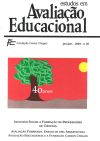Demanda por ensino superior: o caso da Universidade Federal da Bahia
DOI:
https://doi.org/10.18222/eae02920042161Keywords:
Economia Da Educação, Educação E Trabalho, Demanda Por Ensino Superior, Capital HumanoAbstract
Este artigo apresenta uma metodologia inovadora para estimação da demanda por educação. Além disso, ele estima, em seção transversal, as demandas agregadas pelos cursos existentes na UFBa a partir da base de dados do Vestibular para os anos de 1993 a 2001(exceto os anos de 1996, 1999 e 2000). Para isto, desenvolvem-se modelos de estimação do custo de oportunidade e de renda vitalícia do aluno. Esta última pode ser interpretada como o estoque de capital humano do indivíduo com educação superior na Região Metropolitana de Salvador. Os modelos estimados apresentam um poder de explicação excepcionalmente alto, com especial destaque para a renda vitalícia, que explica mais de 80% da variabilidade da demanda. Isto demonstra a viabilidade de se utilizar o número de matrículas como proxypara o estoque de capital humano em modelos de crescimento econômico, como é usual na literatura de growth accounting. Outros resultados são apresentados, como as elasticidades da demanda e a taxa marginal de substituição entre o custo de oportunidade e a renda vitalícia.Downloads
Downloads
Published
How to Cite
Issue
Section
License
Authors who publish in this journal agree to the following terms:
a. Authors retain the copyright and grant the journal the right to first publication, with the paper simultaneously licensed under the Creative Commons Attribution license that allows the sharing of the paper with acknowledgment of authorship and initial publication in this journal.
b. Authors are authorized to assume additional contracts separately, for non-exclusive distribution of the version of the paper published in this journal (for example publishing in institutional repository or as a book chapter), with acknowledgment of authorship and initial publication in this journal.
c. Authors are allowed and encouraged to publish and distribute their paper on-line (for example in institutional repositories or on their personal page) at any moment before or during the editorial process, as this can generate productive changes, as well as increase the impact and citation of the published paper (See The Effect of Open Access).





